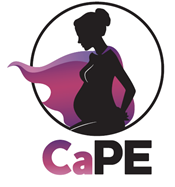About CaPE
CaPE is a parallel-two-arm, randomised, triple-blinded, placebo-controlled multi-centre trial, with a 12-month internal pilot and health economics evaluation.

Aim
To investigate the clinical and cost-effectiveness of calcium supplementation plus usual care compared with usual care alone for prevention of pre-eclampsia and its complications in women at high risk of pre-eclampsia.
Total number participants
7756 women (approximately 3878 in each group). This will allow 90% power (p=0.05) to detect a 20% relative risk reduction in pre-eclampsia from 11.5% down to 9.2%, allowing for a 5% loss to follow up.
Outcome Measures
Primary outcome:
Clinician diagnosis of pre-eclampsia, as defined by the International Society for Study of Hypertension in
Pregnancy (ISSHP): (blood pressure ≥140/90mmHg AND either significant proteinuria (protein/creatinine ratio<
(PCR) of 30 mg/mmol or more) OR maternal multiorgan dysfunction: acute kidney injury (AKI) (creatinine ≥90
μmol/L; 1 mg/dL), liver involvement (elevated transaminases e.g. ALT or AST>40IU/L) with or without right
upper quadrant or epigastric abdominal pain), neurological complications (examples include eclampsia, altered
mental status, blindness, stroke, clonus, severe headaches, persistent visual scotomata), haematological
complications (thrombocytopenia – platelet count below 150,000/μL, DIC, haemolysis) OR uteroplacental
insufficiency (fetal growth restriction, abnormal doppler, stillbirth) developing at or after 20 weeks gestation,
assessed up to primary hospital discharge.
Key secondary outcomes
1. Severe pre-eclampsia index: any one of severe pre-eclampsia, early onset pre-eclampsia <32 weeks,
eclampsia, placental abruption, HELLP syndrome or severe gestational hypertension.
2. Preterm birth <37 weeks
Secondary outcomes:
1. For the woman: Core outcome set (COS) outcomes: death, eclampsia, stroke, retinal detachment or cortical
blindness, pulmonary edema, acute kidney injury, liver capsule haematoma or rupture, raised liver enzymes,
low platelets, abruption, postpartum haemorrhage, ITU admission, and mechanical ventilation. In addition to
these COS outcomes, we will record gestational hypertension, severe hypertension, severe pre-eclampsia,
HELLP syndrome, early onset pre-eclampsia, preterm delivery at <37 weeks for pre-eclampsia, use of
magnesium sulphate for pre-eclampsia, onset of birth, mode of birth, adverse effects: maternal
hypercalcaemia, renal stones, and stopping of medication due to adverse effects.
2. For the baby: COS outcomes: death up to hospital discharge, gestational age at delivery, birthweight, small
for gestational age, neonatal seizures, admission to neonatal unit, respiratory support, and neonatal brain
injury (hypoxic ischaemic encephalopathy, stroke, intraventricular haemorrhage, periventricular
leukomalacia). In addition to these COS outcomes, we will record chronic lung disease, necrotising
enterocolitis requiring surgery, retinopathy of prematurity requiring treatment, a composite of death or
serious morbidity, level of neonatal care and length of stay.
3. Health economics outcomes: We will combine the clinical data collected within the trial with cost data from
previous studies and the NHS to calculate the cost per case of pre-eclampsia avoided.